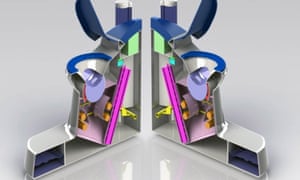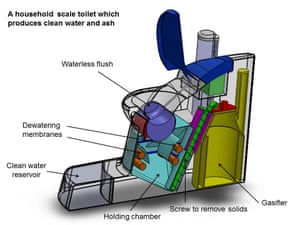

Human excrement is rife with pathogens, “odorant volatiles” (the chemicals that make it smell) and parasites, but it has something going for it: it’s about 75% water. What’s more, water is the smallest of all its component molecules.
It’s these qualities of our faecal matter that got researchers at Cranfield WaterScience Institute thinking about how to make a new kind of toilet that can provide safe sanitation to the 2.5 billion people around the world who do not currently have it.
The result was the nano-membrane toilet which removes the water from human waste and leaves solids that can be used as fuel or fertiliser. It works by using a process called “pervaporation” – where mixtures of liquids are separated by vaporisation through a membrane.
The vapour is then recovered and drained into a collection vessel so it can be used for irrigation, household washing or even human consumption. The ingenuity of the nano membrane toilet is that it works without water or electricity, two key services lacking for many of those without access to toilets.
Instead of a flush, the toilet uses a scraper mechanism that sends the waste from the toilet bowl into a collection tank below, where the solids collect at the bottom as sediment and where the liquid waste is filtered. The solid waste is removed into a gasifier which converts it into gas and energy. According to Alison Parker, a water and sanitation expert at Cranfield University, there should be enough surplus power to charge a mobile phone.
The smart toilet is currently being trialled in Ghana. As well as the evident environmental advantages from its self-sustaining treatment system, the toilet promises to provide people with a clean and safe household alternative to the public lavatories that many currently use. This is of particular value to women and girls, who are often vulnerable when going to the toilet outside the house.
Market uptake challenges
Even if the technology proves robust outside the lab, numerous challenges still stand in the way of the toilet’s uptake.
Commercialisation is the most obvious. Parker and her colleagues are weighing up a range of options, but the most likely is a rental model that removes the need for customers to pay up front. Local entrepreneurs could also benefit from providing regular maintenance, the cost of which could be easily bundled into the regular rental package.
Loowatt, another waterless toilet manufacturer on Parker’s radar, also uses a regular low-cost payment system for its operations in Madagascar. Loowatt, which uses an anaerobic digestion system, charges customers $1.10 (76p) per week to buy refills of the packaging where the waste is stored. “We set the price at an affordable level. If they need more refills they buy more; if they need fewer, they buy fewer,” says Virginia Gardiner, the firm’s chief executive.It’s an approach that has a proven record, says Parker, pointing to the Clean Teamproject in Ghana. The project rents portable toilets to residents in Ghana’s Kumasi district and charges them a fee to collect the waste two or three times a week. To date, nearly 700 toilets have been installed, benefitting 4,500 people.
Driving down costs
Another issue is affordability. The toilet’s designers have yet to fully cost out the nano-membrane toilet as it remains at a prototype stage. However, Parker notes that the hollow-fibre membrane materials are available off the shelf, given their current use in industrial applications such as blood oxygenation and beer nitrogenation, so don’t have to be specially manufactured.
In-country manufacture, an approach envisioned by RTI International is another practical means of keeping production costs low. In addition, RTI’s multi-use toilet block, which converts human waste into burnable fuel and stored energy, uses uniform-sized tanks in an effort to standardise production as much as possible.
“During 2016 we’re working with commercial partners in India to demonstrate [the technology] and hopefully progress towards manufacturing in-country,” says Myles Elledge, a senior director at RTI. “We are targeting [a cost] of about $2,500 per unit, which would serve about 50 users per day and would get us tothe Gates Foundation target of five cents per person per day over a 10-year life.”
Cultural context is all-important, too. You can have the most efficient, most sustainable, most affordable toilet in the world, but social mores and cultural habits may still prevent people using it. According to Parker demand for western-style seat toilets in Africa is high, while squat toilets remain culturally preferable in Asia.
In the case of the nano-membrane toilet, its promoters are looking to pitch it as an “aspirational product”. As Parker says, “We need to make sure we get the marketing right so that people believe it’s a product that they want to invest in.”
source: http://www.theguardian.com/sustainable-business/2016/feb/07/waterless-toilet-turns-your-poo-into-power-nano-membrane-technology
by Oliver Balch
http://www.thisoldtoilet.com

No comments:
Post a Comment